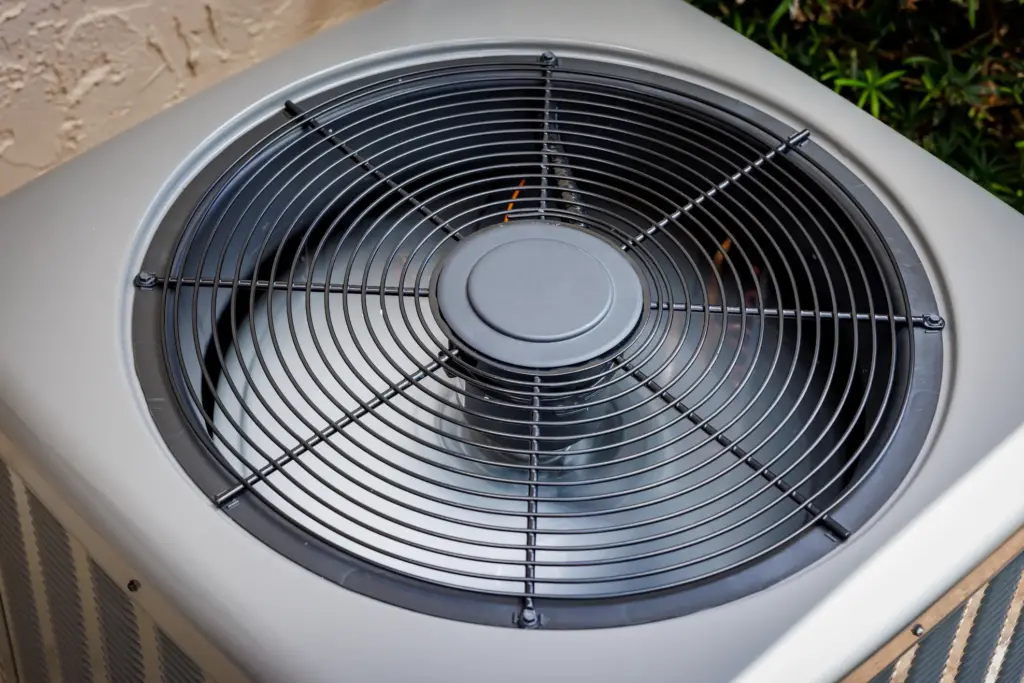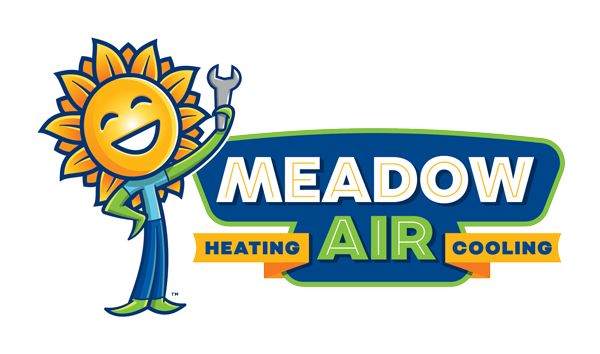Condenser Fan Not Running? Step-by-Step Troubleshooting Guide

If your HVAC system is malfunctioning, it could be due to your condenser fan not running. This can disrupt the cooling process, making your space uncomfortable.
If you’re eager to find a solution without necessarily contacting a professional immediately, this step-by-step guide will take you through the troubleshooting process.
With clear explanations and practical advice, we’ll help you identify and possibly solve the issue at hand.
If you don’t want to do the troubleshooting yourself, don’t hesitate to contact Meadow Air for assistance.
What Is the Purpose of a Condenser Fan?
The condenser fan is an essential part of an HVAC system. Its primary role is to expel heat absorbed from your home and dissipate it outdoors.
It works in unison with the condenser coils and compressor, aiding in changing the high-pressure refrigerant vapor into a high-pressure liquid.
By keeping the condenser coil cool, it ensures that your HVAC system functions at optimal performance.
Without a functioning condenser fan, the system’s efficiency decreases, leading to a warmer-than-desired indoor environment.
What Can Cause a Condenser Fan to Stop Running?
There are several conditions that can cause a condenser fan to not run at all and these include:
- Blocked Air Filter: One surprising reason that can lead to condenser fan malfunction is the air filter. HVAC units’ air filters should be changed every one-to-three months. When the air filter isn’t regularly changed, particulates can accumulate on the filter, which eventually prevents air flow.
- Debris or insects Inside the contactor: If debris or insects get stuck inside the contactor, this can hinder the fan’s operation.
- Contactor Coil Burned Out: The contactor coil can burn out over time due to wear and tear, ultimately leading to the condenser fan malfunctioning.
- Dirty Contactor Contacts: If the contactor’s contacts become dirty, this can prevent the fan’s motor from receiving the necessary power.
- Faulty Condenser Fan Motor: The fan motor plays a crucial role in the fan’s operation. The failure of the motor could result in the fan not running.
- Broken Condenser Fan Belt: The belt in a belt-driven condenser fan can wear out or break, leading to the fan not circulating air properly.
Issues with the AC Compressor: If the AC compressor is on but the fan isn’t running, it may be due to failure within the compressor.
What Are the Common Symptoms of a Faulty Condenser Fan?
There are several tell-tale signs associated with a failing condenser fan that can affect the performance of your HVAC system.
Noticing such symptoms early can prevent potential expensive repairs and uncomfortable ambient temperatures.
- Insufficient Cooling: Your home doesn’t cool down as effectively as before. If your HVAC system is on and working, but the indoor temperature isn’t noticeably dropping, your condenser fan could be malfunctioning.
- Unusual Noises: If strange noises, like grinding or squealing, are coming from your outdoor HVAC unit, it’s usually a tell-tale sign of a fan issue. Such noises can be due to failing motor bearings or loose components.
- Frequent System Cycling: If your AC is turning on and off more frequently than normal, this is often a symptom of an overheating system. This issue can occur when the condenser fan is not dissipating heat as it should.
- Fan Blades Not Spinning: One clear symptom of a condenser fan issue is when the fan blades aren’t spinning, even when the rest of the HVAC system is running.
- Slow Fan Speed: Sometimes the fan might still spin even if it’s malfunctioning. If it spins slower than usual, this could indicate a failing motor or issues with the power supply.
- Abnormal Vibrations: Besides strange noises, another sensation to look out for is unusual vibrations coming from the outdoor unit. This could mean there’s an issue with the fan or its motor.
Pre-Troubleshooting Tips
Before troubleshooting any issues with your HVAC system, it’s important to prepare yourself and your workspace. This is to ensure your safety and prevent the risk of damaging your HVAC system.
Safety First: Disconnect the Power
The most critical aspect of any maintenance or troubleshooting work is prioritizing safety. Always disconnect the power to your HVAC system before starting any inspection, cleaning, or repair.
Turn off the main power switch, which is typically located near the outdoor unit for central air systems.
For extra precaution, you can also switch off the relevant breaker in your home’s electrical panel.
Equip Yourself with the Necessary Tools
Gathering your tools and resources before you begin can help streamline the troubleshooting process. A few items that might come in handy when dealing with HVAC issues include:
- A multimeter for testing electrical components
- A soft brush and vacuum for dusting off any debris
- A set of screwdrivers and pliers for opening panels and tightening connections
- Electric motor oil, if your condenser fan motor requires lubrication
Follow Manufacturer’s Guidelines and Refer to the User Manual
Manufacturer guidelines and user manuals contain essential information specific to your HVAC system. They can influence safety measures, troubleshooting steps, and component replacement requirements.
Make sure to consult the user manual for your HVAC unit when assessing issues, as it may have model-specific instructions or recommendations.
Follow the guidelines provided by the manufacturer to ensure the continued safety, efficiency, and reliability of your system.
And if in doubt, contact your manufacturer for support or clarification. They have in-depth knowledge of your HVAC model and could provide valuable assistance.
Step-by-Step Troubleshooting Guide
Follow these steps to diagnose issues with a condenser fan.
Visual Inspection
Start by visually inspecting the condenser fan and its surroundings. Check for any visible damage or debris around the fan that could potentially impede its operation.
Inspect the fan blades carefully as well for any signs of wear, breakage, or bending. Damaged blades can lead to imbalance, noise, and inefficient operation.
Test the Motor
Investigate if the motor is causing the fan to malfunction. Listen for unusual sounds originating from the motor, like grinding or whining, as these noises might indicate bearing issues.
Feel the motor with your hand (after disconnecting power for safety) to check for excessive heat, which could suggest the motor is overheating.
Inspect the motor visually for any signs of burning or smoke, which undoubtedly denote a burned-out motor.
Check the Capacitor
The capacitor plays an essential role in starting the motor and keeping it running. If it’s faulty, the fan won’t spin.
Check the capacitor for leaks, bulging, a burning smell (indicating a short circuit), discoloration, or any other signs of damage.
Please note that testing a capacitor should always be done by a professional or someone with the right equipment and experience, as it can otherwise be dangerous due to the high voltage stored within.
Check the Electrical Connections
The integrity of the wiring and electrical connections is vital for the condenser fan to function correctly.
Search for any loose or corroded connections and tighten or replace them as needed.
Check the overall status of the wiring. Wires that are frayed or show signs of wear and tear should be replaced.
Test the Thermostat
The thermostat controls the operation of the whole system, including the condenser fan. Ensure the thermostat is set to the correct settings and is working as it should.
If the thermostat display is blank, check whether it needs new batteries. If something still looks off, you may need a professional to verify if it’s sending the correct signals to the HVAC system.
Assess the Contactor Relay
The contactor relay is responsible for supplying power to the fan.
Check if its contact points are burned out or pitted, as this can cause issues with powering the fan.
Look for signs of a worn-out contactor, like a buzzing or humming noise or a stuck contact point that might prevent the fan from turning on.
Remember, before you do any diagnosis or repairs, always turn off the HVAC system and disconnect the power.
Potential Solutions for a Faulty Condenser Fan
Here are a couple of ways you can go about dealing with a condenser fan that’s not running.
Cleaning and Maintenance
Dust, dirt, and debris can collect on the fan blades over time, reducing efficiency and potentially causing damage. Carefully clean the blades with a soft brush and use a vacuum to remove dust from the fan area.
Some condenser fan motors require regular oiling to keep them running smoothly. Check your unit’s manual for specifics. If it necessitates regular lubrication, use a few drops of electric motor oil on each of the motor’s oil ports.
Also, ensure ample airflow. The outdoor unit of your HVAC system should have enough space around it for unrestricted airflow. Clear any leaves, grass, or shrubs that might be blocking the air vents.
Repair or Replace Faulty Components
The decision between repairing and replacing often depends on the cost, the age of your unit, and the specific component that’s faulty. If the cost of repair is nearing 50% of the cost of a new unit, considering replacement might be a better long-term decision.
Always refer to your unit’s manual to find the exact requirements for replacement parts. Authentic parts extend the lifespan of your unit and protect its warranty. Seek out vetted suppliers or consult with a qualified technician to ensure you get quality components.
Consider Professional Help
If your HVAC isn’t cooling sufficiently even after your troubleshooting efforts, or if you’re facing complex issues like motor or electrical problems, it’s best to call a HVAC technician. They have the necessary expertise and tools to properly diagnose and fix the problem.
Regular HVAC maintenance by a professional can extend the lifespan of your unit, increase its efficiency, and help prevent major failures. Having a maintenance plan in place can save you time and money in the long run.
In Conclusion
A faulty condenser fan can disrupt the normal functioning of your HVAC system, causing discomfort.
Spot the signs, perform troubleshooting, but if the issue persists, seek professional assistance.
Need help? Don’t sweat it – contact us today for all your HVAC solutions.
